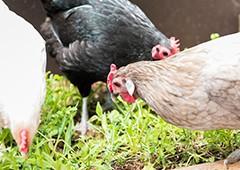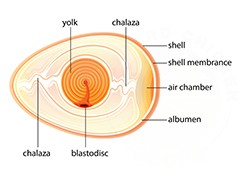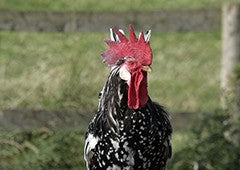
Australorps are a favourite in Australian backyards - and there’s plenty of good reasons why they are so popular. Lots of delicious eggs, a beautiful, calm temperament (plus they’re a true blue Aussie breed!) Read on to hear more about this gorgeous local chicken breed.
Lifespan
Australorps live to be approximately 6-10 years of age.
Class
The Australorp is part of the ‘English’ class of chicken.
Rarity
The Black coloured Australorp is the most common and popular in Australia - the blue variety is a little harder to come by, but it’s worth asking any Australorp breeders whether it is in stock if you are partial to this beautiful colour! The black is certainly still a fine choice, and is egg-sactly the same except for the colour.
Origin
The Australorp is a breed native to Australia - having been bred from the Orpington chicken. It was bred to be a good dual purpose chicken, as it is a heavy breed that lays eggs productively, regardless of weather patterns or seasonal changes.
Fun Facts
-
Is known as the ‘Australian Orpington’, as it was bred from this English chicken breed.
-
It is said that an Australorp chicken holds the record for the most eggs laid by a chicken - one hen laid 364 eggs in 365 days! Not a bad effort.
-
After this record was set by the Australorp, the breed was introduced to the UK, however they did not lay nearly as much - whether the climate or the chicken was to blame still remains the question!
Current Use/Purpose
Australorps are used primarily as a dual purpose birds, as well as family pets - this is because they have such a sweet temperament, are productive egg layers and also have a significant amount of meat on them.
Personality and Temperament
Australorps are a very gentle natured, docile breed that become attached to their owners as much as you will to them! They are egg-stremely calm and are a delight in any urban or acreage backyard - they are also great for families with children, because they are so tame.
Australorp Roosters
Males and females are mainly identified by their body and feather shapes. An Australorp rooster will hold his head up higher than the tallest point of his tail. They also have taller combs which are a more vibrant color. Although both Australorp roosters and hens have black feathers, the males have long, narrow feathers with pointed tips over their necks, shoulders and rumps.
You'll also find Australorp roosters frequently crowing! Hens will more likely only make clucking sounds - but this isn't always the case!
Incubating and Hatching
The Australorp does occasionally display broody behaviour (their English counterpart the Orpington is a very broody breed), however they aren’t a reliable breed that will sit on the eggs to term. If you do find a reliable broody Australorp that incubates to term, they do have good mothering instincts, and will be doting hens to their baby chicks!

Egg Behaviour
Australorps are egg-stremely productive egg layers - sure to satiate your cravings for omelettes and pavlovas. They lay 250-300 large, light brown eggs each year, which is good news for any egg enthusiasts!
Appearance
Australorps are quite large birds (weighing in at around 3-4kgs) with Australorp roosters weighing at the higher end of that average, and have beautiful soft feathers which are lovely to touch. Their feathers, when shining in the sun, contain a few subtle hints of vibrant colours such as purple and green - quite a beautiful sight! They come in three different variations - black, white and blue (although the white variety isn’t hugely popular).
The Australorp can also be found as a bantam variety.
Care
As far as care goes, Australorps don’t require any extra grooming techniques outside what we do for normal chickens. Because Australorps are heavy, they aren’t flighty and can’t get far, so you shouldn’t need to clip their wings.
Health Issues
Australorps aren’t regarded as having any particular ailments specific to their breed. They should be wormed regularly, like all chickens, and vaccinated if necessary (if there are known chicken illnesses in your area). Otherwise, your flock should stay fighting fit, as long as they’re well protected from predators.
Hardiness
Because of their heavy weight, the Australorp can withstand cold winter temperatures easily, as well as hot weather - they were bred here after all! They are even said to keep laying whilst the temperature is especially hot and cold - what a trooper.

Why We Love Them!
Australorps are just great in virtually every sense - they’re productive egg layers, and make loving family companions. Plus, they were bred here, so we have a little sense of pride from having Australian chickens in our Aussie backyard! Want to know more? Check out our 5 reasons to love Australorps here!
If you're still considering which breed is best for you, why not check out the online chicken courses by our friends at Chickenpedia. They have a specific course dedicated to Chicken Breeds where they compare each breed to suit your needs and lifestyle very well.
Australorps are a great breed for a number of reasons - check out these comprehensive breed profiles articles about other fabulous breeds!
Comprehensive Guide to Isa Browns:
/isa-browns-a-comprehensive-guide
Comprehensive Guide to Plymouth Rocks:
http://www.backyardchickencoops.com.au/plymouth-rock-a-comprehensive-guide

















